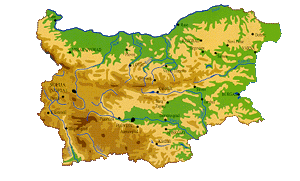
 |
BULGARIAN CHAMBER OF COMMERCE AND INDUSTRY |
BULGARIA - Country Profile
 |
LOCATION: Located on the Balkan Peninsula, Bulgaria extends from the western shore of the Black Sea to Yugoslavia and Macedonia in the west. In the north, the Danube River forms the greater part of Bulgaria's common border with Romania. Greece and European Turkey lie to the south and southeast of Bulgaria.
The country is divided roughly into three parallel east-west zones: the Danubian tableland in the north, the Stara Planina (or Balkan) Mountains in the center, and the Thracian Plain and the Rhodope and Pirin Mountains in the south and southwest. About one- third of the country lies at an altitude of 500 meters (1,640 ft.) above sea level. The average elevation is 480 meters (1,575 ft.) above sea level.
AREA: 110,987 sq. km. (44,365 sq. mi.).
POPULATION: 8 190 876, population in towns 5 578 000, population growth -4,8 0/00
CAPITAL: Sofia (pop. 1,114,759).
MAIN TOWNS: Plovdiv (377,637), Varna (297,090), Bourgas (188,367), and Rousse (185,425).
CLIMATE: On the fringe of the humid continental climate zone. The weather varies considerably from year to year, as do the several climatic subzones within the country. Summer temperatures average about 24 C (75 F); winter temperatures average around 0 C (32 F). Annual precipitation averages 63 centimeters (25 in.).
OFFICIAL LANGUAGE: Bulgarian.
LEGAL SYSTEM: Parliamentary Republic
Unicameral National Assembly of 240 deputies (last election date 17 June 2001):
HEAD OF STATE: George Parvanov - President (since 22 January 2002).
PRIME MINISTER: Simeon Borisov Sakskoburggotski (NDSV) (since 24 July 2001).
ETHNIC GROUPS: Bulgarian 87.8%, Turk 8.5%, Gypsy 2.6%, other 1.1%
RELIGIONS: Bulgarian Orthodox 85%, Muslim 13%, Jewish 0.8%, Catholic 0.7%, and other 0.5%
NATIONAL HOLIDAY: 3 March - The Day of the Liberation of Bulgaria from Ottoman Rule (1878).
| OFFICIAL HOLIDAYS: |
|
ADMINISTRATIVE ORGANIZATION: 28 districts.
TRANSPORT: The railway transport is of great significance for the country. The total length of the railway network is 7,353 km, and of the road network is 31,404 km. The sea and river (along the Danube river) fleet take an active part in the trade of the country. The major sea ports are Varna and Bourgas, and the main Danube ports are Rousse, Lom, Svishtov, Vidin. There is a ferry-boat connection between Vidin and Kalafat (Romania). The main airports are: Sofia Airport, Bourgas Airport, Varna Airport, Plovdiv Airport.
CURRENCY: Lev (BGN). Currency board 1BGN = 1DEM
WEIGHT AND MEASURS: Metric system
ECONOMIC PROFILE
The Economy in 2000
| Real GDP growth (%) | 5.8 |
| GDP (mln leva) | 25 454 |
| GDP per head ($) | 1 459 |
| Budget balance (% of GDP) | -1.1 |
| Unemployment rate by December 31, 2000 (Rate of unemployed persons registered at the employment offices related to the total of employed and unemployed persons -%) |
16.4 |
| Annual average inflation (based on1999) - % |
11.4 |
| Wage inflation (Index of the average salary based on 1999) |
118.43 |
| Exchange rate Lv: $ (average annual) |
2.124 |
| Exchange rate Lv: DM (Exchange rate of BNB) |
1.000 |
| BNB interest rate (at the end of the period - %) |
4.63 |
| Goods: exports fob ($ mln) |
4 824 |
| Goods: imports fob ($ mln) |
6 000 |
| Trade balance ($ mln) |
-1 175.5 |
| Gross external debt ($ mln.) |
10 364 |
Notes: Main Source of Information: National Statistical Institute, Council of Ministers